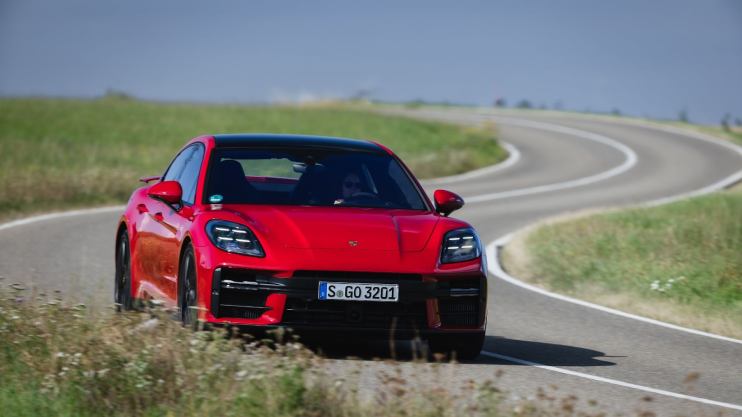Porsche Panamera GTS 2024 review: A sports car for all the family

Stonking V8 engines without electrical assistance have suddenly become an endangered species. Not long ago, all of Germany’s super saloons followed this recipe; now the BMW M5 has become a plug-in hybrid, while the Mercedes-AMG E63 has thundered off into the sunset, replaced by the E53 and its hybridised straight-six.
Aside from the (largely forgotten) Audi RS7 Sportback, that makes the 2025 Porsche Panamera GTS something of an anomaly: a new car with an old-fashioned approach to going fast.
If electric tech can boost horsepower and miles per gallon, though, surely that’s a good thing? Well, to park my posterior on the nearest fence, it depends on what you want. Thanks to stronger performance and lower running costs, plug-in hybrids clearly deliver on paper. But the GTS, with its emotive engine and engaging chassis, ably counters those arguments on the road.
A single-minded sports saloon
The third-generation Porsche Panamera was launched earlier this year and the lineup now stretches from the 353hp rear-driven model (£82,500) to the 782hp Turbo S E-Hybrid (£168,700). With 500hp and a price tag of £125,600, the new GTS sits more or less in the middle.
In recent times, the Panamera has felt like an awkward cousin in the Porsche family: outsold by the Macan and Cayenne SUVs, outshone by the 718 and 911 sports cars, and simply less cool than the electric Taycan. The more single-minded Panamera GTS seems different, though. Arguably, it’s the closest you’ll get to a four-door, family-sized Porsche 911.
Let’s start with that V8: a 4.0-litre twin-turbocharged firecracker that product chief Oliver Grandel says is “tuned to feel like a naturally aspirated engine”. Driving all four wheels via a PDK dual-clutch auto transmission, it accelerates the Panamera to 62mph in 3.8 seconds and a maximum of 188mph.
The GTS also sits 10mm lower on two-chamber air springs and conventional adjustable dampers, with anti-roll bars that are twice as stiff and a torque vectoring rear differential. There’s no rear-axle steering or 48-volt active ride hardware – as found elsewhere in the range – to avoid diluting the driving experience.
Sumptuous and sporty
The latest Panamera looks less like a squashed 911 than its predecessors, with a muscular stance and a tapering roofline that allows for a practical rear hatchback (sadly, there will be no Sport Turismo estate this time – it’s been axed due to slow sales).
You could easily miss the subtle bodykit and ‘GTS’ decals, but not the 911 GT3-style centre-lock wheels: serious stuff for a saloon car. My test Porsche had the optional (£7,700) PCCB carbon-ceramic brakes for good measure.
Inside, the Panamera strikes an appealing balance between sumptuous and sporty. There’s a full complement of screens (a 12.6-inch curved driver display, 12.3-inch central touchscreen and 10.9-inch display for the front passenger), with most surfaces swathed in grippy Race-Tex – Stuttgart’s answer to Alcantara.
Climb aboard and you’ll discover big-bolstered seats and a driving position that’s likeably low-slung. The rear bench is shaped into two individual seats and legroom is generous, although the low roof makes headroom more limited. Stuff-pack the boot and you can carry a very useful 478 litres.
Ready to rumble
The 500 Pferdestärke produced by the Panamera looks a tad anaemic when the (£14,000 cheaper) BMW M5 can muster 727hp. However, the BMW also weighs a whopping 370kg more than its Porsche rival – at 2,435kg versus 2,065kg – so the heavyweight hybrid is only 0.3 seconds quicker to 62mph.
Anyway, the GTS isn’t really about straight-line speed. Its V8 doesn’t deliver the instant, electrified punch of a PHEV, but it relishes high revs. There’s no turbo lag to speak of, just a linear progression of power, amplified by an authentic V8 rumble from the standard-fit sports exhaust.
As in other Porsche products, the eight-speed PDK gearbox is nigh-on impossible to fault, shifting smoothly and intuitively in automatic mode, then proving instantly responsive if you use the paddles. I couldn’t resist the urge to swap cogs myself, holding onto gears longer than necessary to hear the V8 in full voice.
An effective bahnstormer
While the Panamera Turbo S E-Hybrid seems to crush the road into submission, the GTS offers a more satisfying sense of flow. It’s involving and confidence-building, with slingshot traction from its four-wheel-drive system and enormous grip from 325-section rear tyres.
The steering is direct and beautifully weighted, while the brakes feel mighty – even when tested at three-figure speeds on the German autobahn. The various drive modes effectively change the character of the car, too. In Comfort, the Panamera is a mature executive express; in Sport Plus, it rolls up its sleeves for the office party.
Some drivers may still consider the GTS a tad on the sensible side. This isn’t a tyre-smoking hooligan like the old Mercedes-AMG E63 S – that’s not the Porsche way. Yet its refinement and sheer breadth of ability make the Panamera easy to live with – and well suited to roads where even 70mph feels like a distant dream (yes Britain, we’re talking about you).
Verdict: Porsche Panamera GTS
Power and speed are commodities that have been devalued in this electric age. When your neighbour’s Tesla can hit 62mph quicker than a Ferrari, the stats no longer seem so important. If you enjoy driving, the subjective stuff matters more.
Call it old-fashioned (we already have), but the GTS is a subjective sort of car. Combining a visceral V8 with a communicative and exploitable chassis, it refreshes the parts other Panameras – and indeed the Porsche Taycan – sometimes fail to reach.
If you can stomach the six-figure asking price and hefty tax bill, now is the time to buy one.
Tim Pitt writes for Motoring Research
Porsche Panamera GTS
PRICE: £125,600
POWER: 500hp
0-62MPH: 3.8sec
TOP SPEED: 188mph
FUEL ECONOMY: 22.2mpg
CO2 EMISSIONS: 274g/km